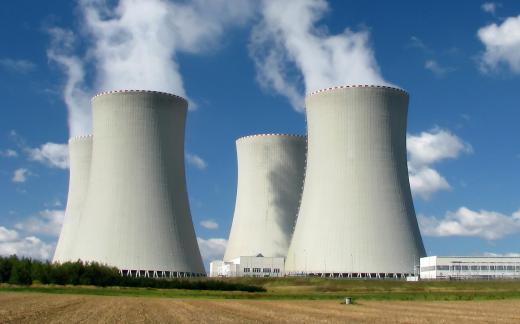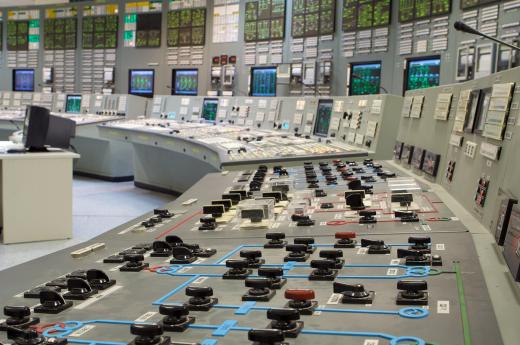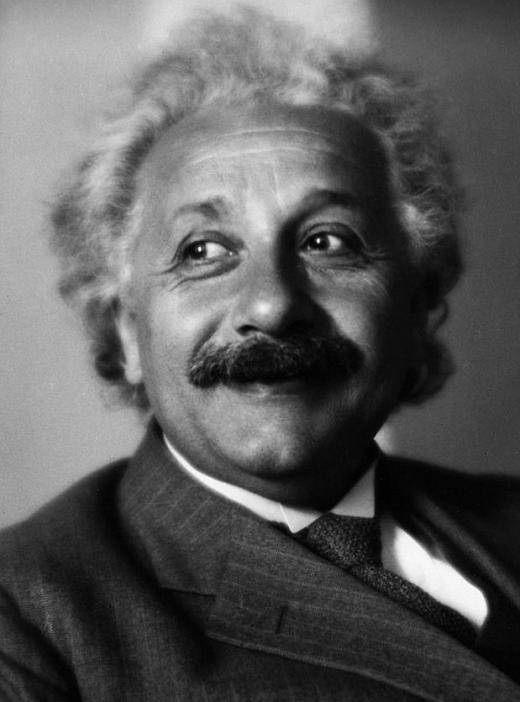What is Nuclear Fission?
Nuclear fission is the splitting of an atom's nucleus, thus creating two products of roughly half the mass of the original. During the process, some neutrons are also released. This process releases a substantial amount of energy. Nuclear fission is the physical process responsible for all types of power generation, including that used in both nuclear weapons and nuclear power plants.
There are a number of elements that can be used in nuclear fission, but the most common is uranium. This material is popular for a number of different reasons, but two of the most important are that it is plentiful, and there are isotopes of uranium that are easy to split. The most commonly used isotope of uranium for nuclear energy production is called U-235. In addition to U-235, plutonium is another substance sometimes used for nuclear power.

For the purposes of nuclear power generation, enriched uranium is needed. This must be approximately 2 to 3 percent U-235 in order to work as it is supposed to. The process of enriching uranium for weapons is nearly the same, with one notable exception. For weapons, the amount of U-235 needs to be closer to 90 percent of the total uranium.
To create nuclear fission, the material must be collected. A free neutron is then shot toward the atom's nucleus. The U-235 isotope absorbs the neutron in its nucleus, but that causes the delicate structure to become unstable. Therefore, it splits almost immediately. The neutrons set free in the process are what causes the energy release. While they seemingly disappear, Einstein's theory notes they are not gone, simply converted into energy.

Problems with nuclear fission arise mainly from the radioactive particles that are present after the material is split. The radiation given off can be at such high levels that it can harm living tissue, causing cancer and other ailments. Therefore, while the initial energy release created can be very powerful and dangerous, there are other dangers to keep in mind as well. One debate, especially for nuclear power plants, is what to do with these radioactive elements. The solution favored by the U.S. government is to bury the material deep under a mountain where, theoretically, it would be sufficiently insulated from causing harm.

Nuclear fission is sometimes confused with nuclear fusion. Whereas the nucleus of atoms are split in fission, they are joined together in nuclear fusion. Both techniques can create a substantial amount of energy. Nuclear fission is a process that creates multiple nuclei and atoms from one. Nuclear fusion is nearly the opposite, where several atoms are coming together to create a single heavier nucleus.
AS FEATURED ON:
AS FEATURED ON:













Discussion Comments
Thanks! This really helped me with my class work!
@ Alchemy- As much as I disagree that nuclear energy is the best answer to averting an energy crisis, I have to agree with your assertion that nuclear power generation is safe. The only known accident where damage was not contained by the plant and safety procedures was Chernobyl. The safety measures in place at Three Mile Island completely contained the disaster, as did the safety measures at the various other military and civilian incidents around the world.
The Chernobyl and Three Mile Island accidents are the only core meltdown accidents in the history of nuclear power generation. Three Mile Island also gave scientists insight into what exactly happens in a core meltdown.
The accident, which occurred in 1979, resulted in a 50% core meltdown. Although there had been fears that a core meltdown would melt right through the earth and out the other side, scientists were able to put this worry to rest. The partial meltdown at Three Mile Island only resulted in the core melting 15 mm into the floor of the containment cylinder before it fused to the bottom.
Nuclear fission used in electricity generation is incredibly safe. As the article explained most of the threat from nuclear fission comes from the waste created in the process.
In the United States, nuclear power plants ensure safety by focusing on both safety and security. I do believe however, that the federal government must adopt a disposal plan that focuses on safety, security, and environmental protection before nuclear power can be an option to solving our energy crisis.
Safe operating procedures focus on the preventative measures that will contain any radiation from an accident. The laws of physics ensure that the nuclear process works as it is supposed to while the safety measures create multiple layers of safeguards to prevent human error.
Security efforts focus on the processes that monitor the movement and access of all nuclear materials, equipment, and data.
These efforts allow nuclear power plants to be some of the safest in the world. Now if regulators could only figure out what to do with the waste
Post your comments